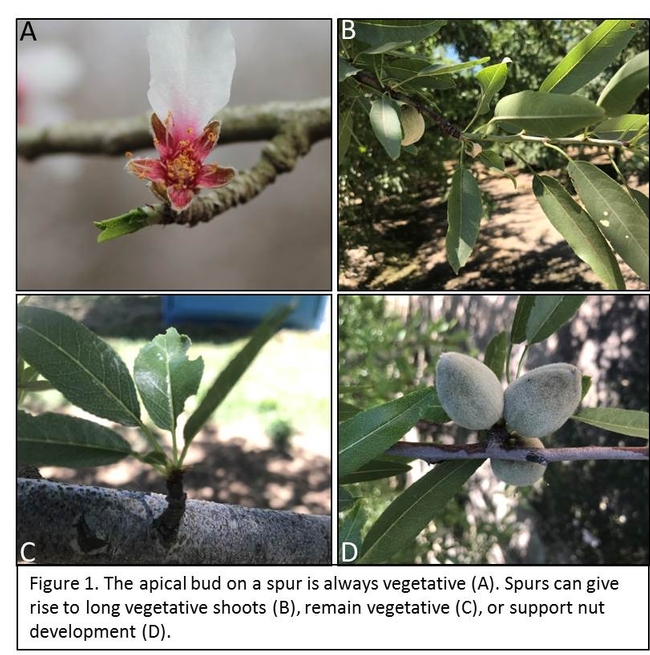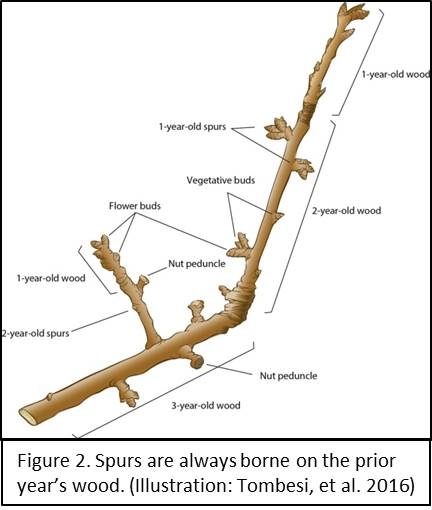Evaluation of flowering and fruit set on almond allows for within-season assessment of orchard productivity; however, understanding the vegetative growth dynamics of almond allows growers to consider parameters affecting productivity years into the future. Vegetative growth of almond has two main components: vegetative shoot growth and spur production. Vegetative shoot growth provides the overall architecture of the canopy, and spur production generates the tissues that give rise to the majority of fruit in subsequent seasons. Both vegetative shoot growth and spur production are key components to the development of an economically sustainable and productive orchard.
Timing of vegetative growth. All buds (vegetative and flower) are formed during the prior season. Because almond has one of the lowest chill requirements of permanent crops grown in California, the chill requirement is generally fulfilled by January 1. As temperatures increase, growth initiation is induced, and bud break ensues, with flower buds breaking in advance of vegetative buds. Vegetative shoot growth proceeds at a somewhat uniform rate throughout the season on young trees, but the durationof spur elongation is short and generally complete by April or early May.
Vegetative buds. On almond, vegetative buds can be distinguished from flower buds by shape. Flower buds are thick and oval; vegetative buds are pointy and triangular. On shoots, flower buds are generally formed on either side of a vegetative bud. On spurs, the apical bud is always vegetative (Figure 1A), and this bud can give rise to either further spur growth (Figure 2) or a vegetative shoot (Figure 1B). Spurs in positions with high light interception are more likely to give rise to vegetative shoots than new spur growth.
Vegetative shoot growth. Vegetative buds may give rise to long vegetative shoots that support future spur production. During the early years of orchard establishment, long shoot growth is the main component of vegetative development on almond (Figure 3A, B, C). On mature trees, vegetative shoot growth occurs under conditions of low crop, high vigor, and in regions of the canopy where there is excessive light interception. Canopy regions with excess light include external/exposed areas and empty spaces resulting from broken limbs.
Spurs. Spurs are short, compact vegetative shoots, approximately 0.5-2 inches long (Figure 2). Spurs arise on vegetative shoots or on spurs produced in the prior season (Figure 2). Within a season, the duration of spur growth is generally short, with spur extension completed by April or early May. Spurs are always formed on the prior year's wood, and remain vegetative for 1-2 years prior to flowering. As a consequence, the process from vegetative shoot growth to spur production and flowering may take 4 seasons.
Spurs support approximately 80% of the total almond yield in a given year, yet only about 20% of the total spur population on a tree supports nut production each year. The fact that only 1 in 5 spurs bear fruit in a season is explained by the dynamic status of spurs between years. A portion of spurs remain only vegetative in a given year (Figure 1C), whereas others may support 1-5 flowers that may develop into single fruit-bearing spurs or multiple fruit-bearing spurs (Figure 1D). Due to the reliance on a localized carbon economy, individual spurs tend to alternate bear, meaning that spurs that bear fruit one year tend not to flower or bear fruit the following year.
Comprehensive view on vegetative growth. In new almond plantings (Figure 3A), growers should expect the mainstay of vegetative growth to be production of long vegetative shoots (Figure 3B and C). Although the majority of the future crop is produced on spurs, it will take time for bearing spurs to be represented in the canopy. Consider that spurs are produced on the prior year's wood and will remain vegetative for 1-2 years before entering productivity. Patience is needed as these vegetative spurs store carbohydrates to support future nut development.
Select References
Tombesi, S., Lampinen, B.D., Metcalf, S., DeJong, T.M. 2016. Yield in almond related more to the abundance of flowers than the relative number of flowers that set fruit. California Agriculture 71: 68-74. Online: https://doi.org/10.3733/ca.2016a0024
Lampinen, B.D., Tombesi, S., Metcalf, S.G., DeJong, T.M. 2011. Spur behavior in almond trees: relationships between previous year spur leaf area, fruit bearing and mortality. Tree Physiology 31: 700-706. Online: https://doi.org/10.1093/treephys/tpr069
Kester, D.E., Martin, G.C., and Labavitch, J.M. 1996. Growth and Development. In: W.C. Micke, Editor, Almond Production Manual. Oakland, California, University of California, Division of Agriculture and Natural Resources (pp 90-97).


